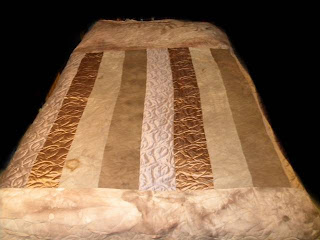I usually look for aesthetic objects to blog about. And I'm running the risk of being untimely, since this blog is being written before the ruling in the Big Chicken lawsuit. But on February 19, I took this pic coming down Highway Ten between Jay and Tahlequah. Its slime. It is river slime from a bar ditch that will be running right to the river. I also photographed a chicken feather just two feet away.
The Illinois River in Northeastern Oklahoma runs thru the heart of the Cherokee Nation. I've played on that river since I was a little bitty kid, either fishing, camping, or just going to the water to play music or have a picnic. It didn't use to ensnarl one's feet in slimy green ooze. But the economics are such that huge monoposonistic poultry companies in Arkansas consider this watershed "out the back door" and establish contracts with growers urging them to expand this direction, thus keeping the White River Basin pristine for the companies' executives playground.
What to do? In Tulsa, there may yet be a lawsuit as yet unruled upon, where AG Drew Edmondson has found attorneys taking it on a contingent fee, to enforce the laws which are aimed at preventing this type of collusive and individual corporate irresponsibility. One law says you can't dump solid waste in this manner. That would apply to the solid waste these farms spread on the land. One law says you can't pollute the waters of Oklahoma--- regardless of whether it is ooze, protein, liquid manure, beneficial fertilizer that gets away. Another law says that when activity within a company's control results in a nuisance to another person's use of the public arena it is actionable. There are other laws too-- the Clean Water Act and its subsequent Safe Drinking Water Act. The SDWA says you can't pollute so much that downstream water treatment plants give people cancer because of all the disinfection by products used. They have a magic number saying what risk is acceptable--- and what risk is more than downstream water users ought not have to put up with. And when the consequence of pollution is measured in number of deaths, that's a pretty tough hardship.
Why on Earth would a neighbor do this to downstreamers? Money. Pure and simple. See, it costs fuel and time to move poultry litter from over-concentrated areas to needy areas elsewhere in other watersheds where every bit of nutrient is captured by a hungry plant before it can dissolve and slide into the water to feed algae. IRW plants are overfed, and can't eat another bite of the stuff... or else there is so much water that drains. Pick a flat, dry watershed, and you'd have the perfect place to apply poultry litter to the surface where it can be used as a fertilizer instead of as a waste disposal sham.
No matter how Judge Frizzell rules, the loser will appeal for about a dozen years and we may not see anything but foot-dragging for as long as Big Chicken can pay lawyers to hold off the changes. When you think about an infinite number of years that waste would have to be trucked away, you can see the logic of foot-dragging. These companies are looking at the long-long perspective and spending money up-front to forestall the day they will have to do right by the river, because it will change their economics.
The first day I sat in on the trials in Tulsa, I was stunned at the contrast. Big Chicken had about 35 lawyers on its side of the case. Oklahoma had seven lawyers and 3 support personnel on its side. Big Chicken made very imaginable objection and tried to twist the Judge's logic. At one point they obtained rulings that vastly changes the possible outcomes, by applying a definition so restrictively. The Judge was ruling that some routine governmental reports were inadmissible, and that really slowed down the State making it very hard and tedious to prove the case. Last time I counted in December, the record was about 16,000 pages of testimony and there were thousands of exhibits. Another trick was to agree to certain documents and then later Big Chicken's attorneys would argue that the documents were not admissible. That crippled Oklahoma by whittling away the evidence. It was, in my opinion, underhanded fraud by the Defendants in the case because they used timing to keep Oklahoma from admitting certain evidentiary facts.
But the outcome is unavoidable. Poultry waste leaves their land in water, which runs into the river and is like vitamin water for algae to grow super-well. The algae changes the habitat for stream biota until it dies, and then it takes the oxygen out of the water making it lifeless for fish and other life forms. Some algae is toxic when it dies. And cities have to bleach the water to make it drinkable... and that bleaching process adds poisons too. To be safe, cities limit their disinfection to a certain level, but sometimes they can't make safe water because the bacteria, dead algae and bleach are too high--- its so polluted that it can't be brought back to safe drinkability.
That's just a thumbnail overview. These companies are very powerful and will tell you that they want to sell cheap chicken so poor people won't starve. To that I say, "Eaters should pay the price, not those who have the misfortune to be a neighbor to these colonizers." The language of conquest applies even today.























